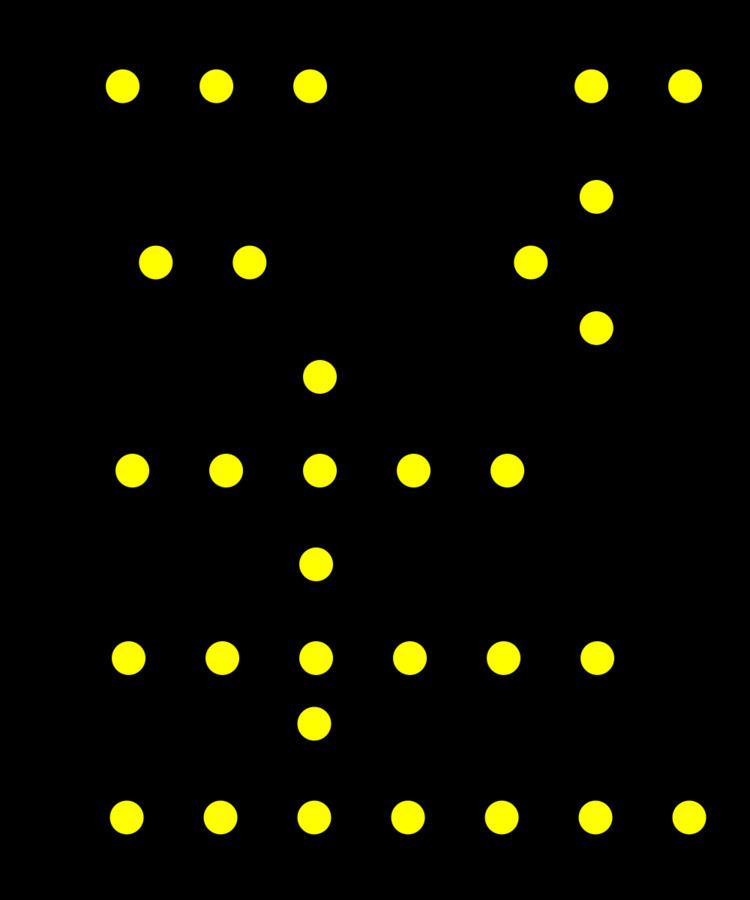 | ||
In mathematics, the ADE classification (originally A-D-E classifications) is the complete list of simply laced Dynkin diagrams or other mathematical objects satisfying analogous axioms; "simply laced" means that there are no multiple edges, which corresponds to all simple roots in the root system forming angles of
Contents
These comprise two of the four families of Dynkin diagrams (omitting
This list is non-redundant if one takes
and corresponding isomorphisms of classified objects.
The question of giving a common origin to these classifications, rather than a posteriori verification of a parallelism, was posed in (Arnold 1976).
The A, D, E nomenclature also yields the simply laced finite Coxeter groups, by the same diagrams: in this case the Dynkin diagrams exactly coincide with the Coxeter diagrams, as there are no multiple edges.
Lie algebras
In terms of complex semisimple Lie algebras:
In terms of compact Lie algebras and corresponding simply laced Lie groups:
Binary polyhedral groups
The same classification applies to discrete subgroups of
Note that the ADE correspondence is not the correspondence of Platonic solids to their reflection group of symmetries: for instance, in the ADE correspondence the tetrahedron, cube/octahedron, and dodecahedron/icosahedron correspond to
The orbifold of
The McKay correspondence can be extended to multiply laced Dynkin diagrams, by using a pair of binary polyhedral groups. This is known as the Slodowy correspondence, named after Peter Slodowy – see (Stekolshchik 2008).
Labeled graphs
The ADE graphs and the extended (affine) ADE graphs can also be characterized in terms of labellings with certain properties, which can be stated in terms of the discrete Laplace operators or Cartan matrices. Proofs in terms of Cartan matrices may be found in (Kac 1990, pp. 47–54).
The affine ADE graphs are the only graphs that admit a positive labeling (labeling of the nodes by positive real numbers) with the following property:
Twice any label is the sum of the labels on adjacent vertices.That is, they are the only positive functions with eigenvalue 1 for the discrete Laplacian (sum of adjacent vertices minus value of vertex) – the positive solutions to the homogeneous equation:
Equivalently, the positive functions in the kernel of
The ordinary ADE graphs are the only graphs that admit a positive labeling with the following property:
Twice any label minus two is the sum of the labels on adjacent vertices.In terms of the Laplacian, the positive solutions to the inhomogeneous equation:
The resulting numbering is unique (scale is specified by the "2") and consists of integers; for E8 they range from 58 to 270, and have been observed as early as (Bourbaki 1968).
Other classifications
The elementary catastrophes are also classified by the ADE classification.
The ADE diagrams are exactly the quivers of finite type, via Gabriel's theorem.
There is also a link with generalized quadrangles, as the three non-degenerate GQs with three points on each line correspond to the three exceptional root systems E6, E7 and E8. The classes A and D correspond degenerate cases where the line set is empty or we have all lines passing through a fixed point, respectively.
There are deep connections between these objects, hinted at by the classification; some of these connections can be understood via string theory and quantum mechanics.
Trinities
Arnold has subsequently proposed many further connections in this vein, under the rubric of "mathematical trinities", and McKay has extended his correspondence along parallel and sometimes overlapping lines. Arnold terms these "trinities" to evoke religion, and suggest that (currently) these parallels rely more on faith than on rigorous proof, though some parallels are elaborated. Further trinities have been suggested by other authors. Arnold's trinities begin with R/C/H (the real numbers, complex numbers, and quaternions), which he remarks "everyone knows", and proceeds to imagine the other trinities as "complexifications" and "quaternionifications" of classical (real) mathematics, by analogy with finding symplectic analogs of classic Riemannian geometry, which he had previously proposed in the 1970s. In addition to examples from differential topology (such as characteristic classes), Arnold considers the three Platonic symmetries (tetrahedral, octahedral, icosahedral) as corresponding to the reals, complexes, and quaternions, which then connects with McKay's more algebraic correspondences, below.
McKay's correspondences are easier to describe. Firstly, the extended Dynkin diagrams
Turning from large simple groups to small ones, the corresponding Platonic groups
Algebro-geometrically, McKay also associates E6, E7, E8 respectively with: the 27 lines on a cubic surface, the 28 bitangents of a plane quartic curve, and the 120 tritangent planes of a canonic sextic curve of genus 4. The first of these is well-known, while the second is connected as follows: projecting the cubic from any point not on a line yields a double cover of the plane, branched along a quartic curve, with the 27 lines mapping to 27 of the 28 bitangents, and the 28th line is the image of the exceptional curve of the blowup. Note that the fundamental representations of E6, E7, E8 have dimensions 27, 56 (28·2), and 248 (120+128), while the number of roots is 27+45 = 72, 56+70 = 126, and 112+128 = 240. This should also fit into the scheme of relating E8,7,6 with the largest three of the Sporadic simple groups, Monster, Baby and Fischer 24', cf. Monstrous Moonshine.
